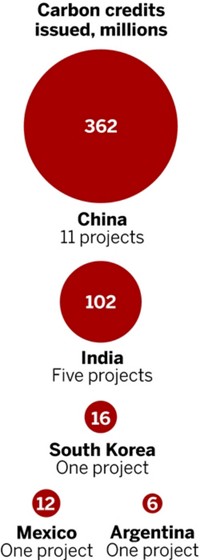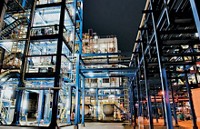Advertisement
Grab your lab coat. Let's get started
Welcome!
Welcome!
Create an account below to get 6 C&EN articles per month, receive newsletters and more - all free.
It seems this is your first time logging in online. Please enter the following information to continue.
As an ACS member you automatically get access to this site. All we need is few more details to create your reading experience.
Not you? Sign in with a different account.
Not you? Sign in with a different account.
ERROR 1
ERROR 1
ERROR 2
ERROR 2
ERROR 2
ERROR 2
ERROR 2
Password and Confirm password must match.
If you have an ACS member number, please enter it here so we can link this account to your membership. (optional)
ERROR 2
ACS values your privacy. By submitting your information, you are gaining access to C&EN and subscribing to our weekly newsletter. We use the information you provide to make your reading experience better, and we will never sell your data to third party members.
Environment
Kyoto’s Low-Hanging Fruit
Is a program intended for developing countries enriching Arkema?
by Melody Voith
July 7, 2008
| A version of this story appeared in
Volume 86, Issue 27

A popular program run by the United Nations is intended to cut industrial emissions of greenhouse gases while bringing advanced technologies to developing countries. But a Chinese project recently announced by the French chemical maker Arkema suggests that the program rewards some companies in the industrialized world more than might be intended.
Ideally, market-driven approaches would be flexible, effective, and fair. In the name of fairness, the 1997 Kyoto protocol divides participating nations into industrialized and developing groups. The pact places the burden of reducing greenhouse gas emissions on the 38 industrialized countries that have ratified the protocol, including France, Germany, and the U.K. The U.S. signed the protocol but never ratified it.
Developing countries are not required to reduce greenhouse gases. However, under the protocol’s clean development mechanism (CDM), investors from industrialized nations can reduce emissions in developing countries and earn certified emission reduction (CER) credits, which they can sell on the international market. The global trade in these credits began in 2005.
But the goals of CDM are more far-reaching. Rather than just letting industrialized nations buy their way to compliance, the program is also intended to assist developing countries in “their pursuits for sustainable development” through foreign investment and technology transfer.
The UN calls CDM a win-win-win program—for the investors, the host country, and the environment. Still, the flexibility inherent in the program makes it difficult to ensure that the many goals are met.
In April, CDM registered its 1,000th project. Just before that milestone, on Feb. 15, it registered Arkema’s project, which will result in a credit for the company’s investors of almost 3.5 million metric tons of CO2 equivalent per year. In today’s market, that’s worth roughly $52 million. As a case study, the project raises questions about who really benefits from the trading scheme.
In 2000, Arkema began operating a plant in Changshu, China. The plant makes HCFC-22, used as a refrigerant and polymer ingredient. It also produces HFC-23, an unintended by-product that the company has been releasing into the atmosphere.
As a greenhouse gas, HFC-23 is potent: One ton of it is equivalent to 11,700 tons of CO2. In China the gas is not regulated, and Arkema saw no reason to capture it. Under CDM, however, capturing and destroying HFC-23 suddenly became a very good investment.
To take advantage of this opportunity, Arkema formed a joint venture called Changshu Haike Chemical and made it the CDM project’s owner and operator. The company states in papers filed with the UN that the joint venture “was solely established to operate this proposed CDM project so as to be in compliance with Chinese law, which only allows [a] Chinese entity or Chinese-holding entity to be eligible to conduct CDM projects with foreign partners.”
Finding a technology to destroy HFC-23 was not a problem. In France, Arkema has used thermal decomposition technology since 1992, eight years before it built the Chinese plant.
When you add it all up, awarding carbon credits for a project of this type looks like a win-win-win mainly for companies and countries in the industrialized world. Arkema was able to operate in China without the expense of destroying HFC-23 for eight years. It will now profit by installing known technology and reaping CER credits. And France can purchase these carbon credits to help it meet its obligation under the Kyoto protocol.
At the same time, it’s hard to see how this CDM project spurs the development of clean industry in China. After all, Arkema is not exactly bringing high-tech pollution control to Chinese factories. Had the fluorocarbon plant been built in France, it would have had the pollution control from the beginning.
Nick Campbell is the environmental manager at Arkema. He acknowledges that Arkema didn’t install decomposition technology at the Chinese plant from the start. On the other hand, he points out that the plant was designed to minimize levels of HFC-23 and that it operates much more cleanly than do similar Chinese-run plants.
Campbell is also a European chemical industry representative to negotiations on carbon trading and therefore has insight into the uncertainties facing carbon credit investors such as Arkema. He explains that the first Kyoto commitment period ends in 2012. Because no one knows yet who will commit, and to what, after 2012, the future value of CER credits is in question.
In Arkema’s defense, Campbell says the firm is undertaking the Changshu project at a time when an oversupply of credits in the EU threatens to reduce their current value. And the next round of agreements may involve new players (perhaps the U.S.) and may require developing countries to cut their own emissions. There may then be an oversupply of investors and fewer projects.
For now, Campbell says, investors are focusing on low-hanging fruit. The CDM database shows 16 other registered HFC-23 projects, nine of them in China. There won’t be many others, though, because HCFC-22 production is being phased out under another treaty—the Montreal protocol to protect stratospheric ozone. But HCFC-22 plants in developing countries, including Arkema’s Chinese plant, will be allowed to operate for an additional 20 years—yet another win for a company in the industrialized world.
Views expressed on this page are those of the author and not necessarily those of ACS.





Join the conversation
Contact the reporter
Submit a Letter to the Editor for publication
Engage with us on Twitter